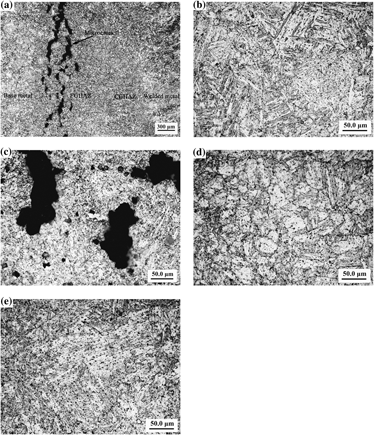Crossref Citations
This article has been cited by the following publications. This list is generated based on data provided by
Crossref.
Jiang, Yun Jian
Jing, Hong Yang
Xu, Lian Yong
and
Zhao, Lei
2011.
Numerical Simulation on Residual Stress Generation in the Crack Tip of ASME P92 Steel.
Advanced Materials Research,
Vol. 421,
Issue. ,
p.
522.
Zhao, Lei
Jing, Hongyang
Xu, Lianyong
Han, Yongdian
and
Xiu, Junjie
2012.
Analysis of creep crack growth behavior of P92 steel welded joint by experiment and numerical simulation.
Materials Science and Engineering: A,
Vol. 558,
Issue. ,
p.
119.
Zhao, Lei
Jing, Hongyang
Xu, Lianyong
An, Junchao
and
Xiao, Guangchun
2012.
Numerical investigation of factors affecting creep damage accumulation in ASME P92 steel welded joint.
Materials & Design,
Vol. 34,
Issue. ,
p.
566.
Zhao, Lei
Jing, Hongyang
Han, Yongdian
Xiu, Junjie
and
Xu, Lianyong
2012.
Prediction of creep crack growth behavior in ASME P92 steel welded joint.
Computational Materials Science,
Vol. 61,
Issue. ,
p.
185.
Zhao, Lei
Jing, Hongyang
Xu, Lianyong
Han, Yongdian
and
Xiu, Junjie
2012.
Evaluation of constraint effects on creep crack growth by experimental investigation and numerical simulation.
Engineering Fracture Mechanics,
Vol. 96,
Issue. ,
p.
251.
Zhao, Lei
Jing, Hongyang
Xu, Lianyong
Han, Yongdian
Xiu, Junjie
and
Qiao, Yaxia
2013.
Evaluating of creep property of distinct zones in P92 steel welded joint by small punch creep test.
Materials & Design,
Vol. 47,
Issue. ,
p.
677.
Xu, Linqing
Yan, Zesheng
Liu, Yongchang
Li, Huijun
Ning, Baoqun
and
Qiao, Zhixia
2013.
Microstructure evolution and martensitic transformation behaviors of 9Cr–1.8W–0.3Mo ferritic heat-resistant steel during quenching and partitioning treatment.
Journal of Materials Research,
Vol. 28,
Issue. 20,
p.
2835.
Wang, J.
Steinmann, P.
Rudolph, J.
and
Willuweit, A.
2015.
Simulation of creep and cyclic viscoplastic strains in high-Cr steel components based on a modified Becker–Hackenberg model.
International Journal of Pressure Vessels and Piping,
Vol. 128,
Issue. ,
p.
36.
Meng, Donghai
Lu, Fenggui
Cui, Haichao
Ding, Yuming
Tang, Xinhua
and
Huo, Xin
2015.
Investigation on creep behavior of welded joint of advanced 9%Cr steels.
Journal of Materials Research,
Vol. 30,
Issue. 2,
p.
197.
Falat, Ladislav
Kepič, Ján
Čiripová, Lucia
Ševc, Peter
and
Dlouhý, Ivo
2016.
The effects of postweld heat treatment and isothermal aging on T92 steel heat-affected zone mechanical properties of T92/TP316H dissimilar weldments.
Journal of Materials Research,
Vol. 31,
Issue. 10,
p.
1532.
Kalvala, Prasad Rao
Akram, Javed
Misra, Mano
Ramachandran, Damodaram
and
Gabbita, Janaki Ram
2016.
Low temperature friction stir welding of P91 steel.
Defence Technology,
Vol. 12,
Issue. 4,
p.
285.
Xu, Lianyong
Wang, Yongfa
Jing, Hongyang
Zhao, Lei
and
Han, Yongdian
2016.
Deformation Mechanism and Microstructure Evolution of T92/S30432 Dissimilar Welded Joint During Creep.
Journal of Materials Engineering and Performance,
Vol. 25,
Issue. 9,
p.
3960.
Shao, Chendong
Lu, Fenggui
Li, Zhuguo
Cai, Yan
Wang, Peng
and
Ding, Yuming
2016.
Role of stress in the high cycle fatigue behavior of advanced 9Cr/CrMoV dissimilarly welded joint.
Journal of Materials Research,
Vol. 31,
Issue. 2,
p.
292.
Xu, Bin
Xue, Song
Cai, Yong
Niu, Jitai
and
Li, Liangchao
2017.
Thermal Simulation Analysis of Microstructure and Hardness for CrMoV with PWHT in Type IV Region.
Metallurgical and Materials Transactions B,
Vol. 48,
Issue. 6,
p.
2813.
Wu, Dongquan
Jing, Hongyang
Xu, Lianyong
Zhao, Lei
and
Han, Yongdian
2018.
Numerical analysis of the creep crack constraint effects and the creep crack initiation for pressurized pipelines with circumferential surface cracks.
Advances in Engineering Software,
Vol. 115,
Issue. ,
p.
40.
Wu, D.
Jing, H.
Xu, L.
Zhao, L.
and
Han, Y.
2018.
Creep crack initiation prediction considering constraint effect for pressurized pipelines with circumferential surface cracks.
Fatigue & Fracture of Engineering Materials & Structures,
Vol. 41,
Issue. 9,
p.
1900.
Zhang, Yu
Jing, Hongyang
Xu, Lianyong
Han, Yongdian
Zhao, Lei
and
Xiao, Bo
2018.
Microstructure and mechanical performance of welded joint between a novel heat-resistant steel and Inconel 617 weld metal.
Materials Characterization,
Vol. 139,
Issue. ,
p.
279.
Liang, Zhiyuan
Zhao, Qinxin
Deng, Jianguo
and
Wang, Yungang
2018.
Influence of Aging treatment on the microstructure and mechanical properties of T92/Super 304H dissimilar metal welds.
Materials at High Temperatures,
Vol. 35,
Issue. 4,
p.
327.
Zhao, L.
Alang, N.
and
Nikbin, K.
2018.
Investigating creep rupture and damage behaviour in notched P92 steel specimen using a microscale modelling approach.
Fatigue & Fracture of Engineering Materials & Structures,
Vol. 41,
Issue. 2,
p.
456.
Zhai, Xiao-wei
Du, Jin-feng
Li, Lin-ping
Zhou, Chao
and
Zhang, Zheng
2019.
Creep behavior and damage evolution of T92/Super304H dissimilar weld joints.
Journal of Iron and Steel Research International,
Vol. 26,
Issue. 7,
p.
751.





